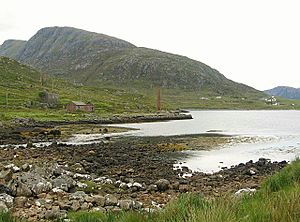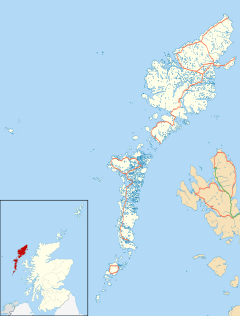Bun Abhainn Eadarra facts for kids
Quick facts for kids Bun Abhainn Eadarra |
|
|---|---|
 The remains of the whaling station at Bun Abhainn Eadarra |
|
| Language | Scottish Gaelic English |
| OS grid reference | NB128041 |
| Civil parish | |
| Council area | |
| Lieutenancy area | |
| Country | Scotland |
| Sovereign state | United Kingdom |
| Post town | ISLE OF HARRIS |
| Postcode district | HS3 |
| Dialling code | 01859 |
| Police | Northern |
| Fire | Highlands and Islands |
| Ambulance | Scottish |
| EU Parliament | Scotland |
| UK Parliament |
|
| Scottish Parliament |
|
Bun Abhainn Eadarra, also known as Bunavoneadar, is a small village in Scotland. It is located on the south shore of North Harris. This area is part of the Outer Hebrides islands. The village sits right next to a loch (a lake) that shares its name.
You can reach Bunavoneadar by road. It is connected to Tarbert, which is the main port for Harris.
Contents
A Look Back: The Whaling Station
Bun Abhainn Eadarra is famous for its old whaling station. A whaling station was a place where whales were brought after being caught. Workers would then process the whales for their oil and other products.
How the Station Started
A man from Norway, Carl Herlofsen, started this station in 1904. It was a busy place for many years. The station operated from 1904 to 1914. It then reopened from 1918 to 1922.
New Owners and Products
In 1922, a company called Lever Brothers bought the station. This company was known for making soap and margarine. They updated the machines and bought three ships. These ships were used to hunt whales in the North Atlantic Ocean.
The main product made at the station was whale oil. This oil was very useful. It was used to make soap and margarine. It also helped with lighting and as a lubricant for machines.
Later Years and Legacy
Just before the station closed in 1929, a new building was added. This building was used to smoke whale meat. The smoked meat was then sold in the Congo. The station did reopen briefly in the 1950s.
Today, the Bunavoneadar whaling station is very important. It is the only remaining example of an early 20th-century shore-based whaling station in the UK. Because of its history, Historic Scotland named it an ancient scheduled monument in 1992. This means it is a protected historical site.


